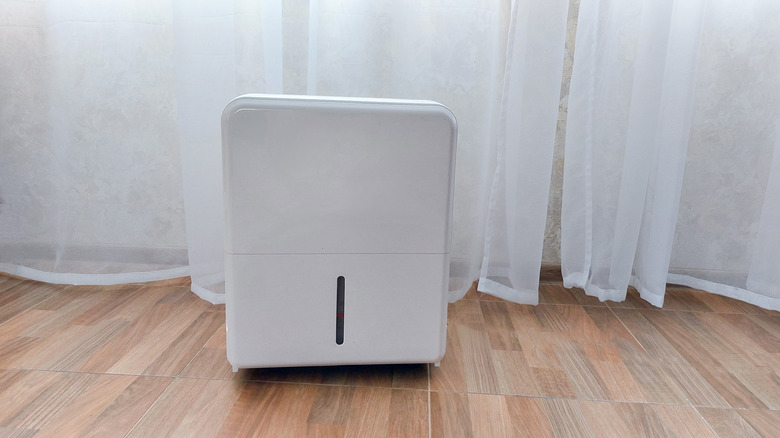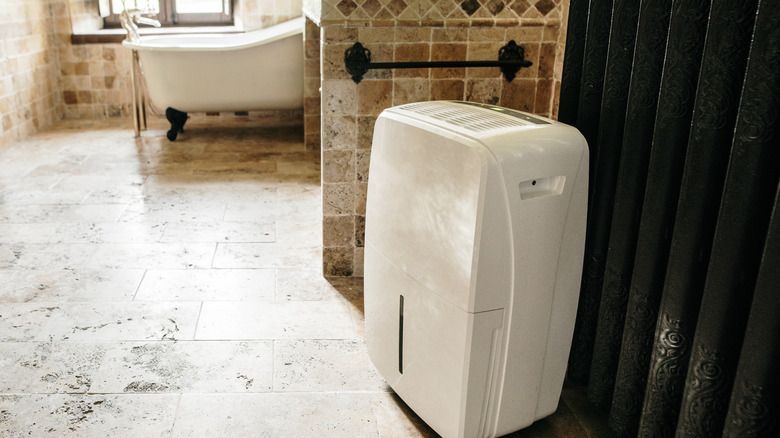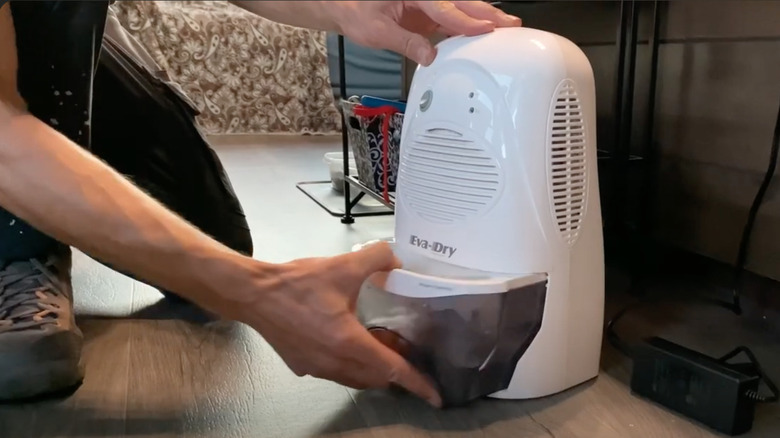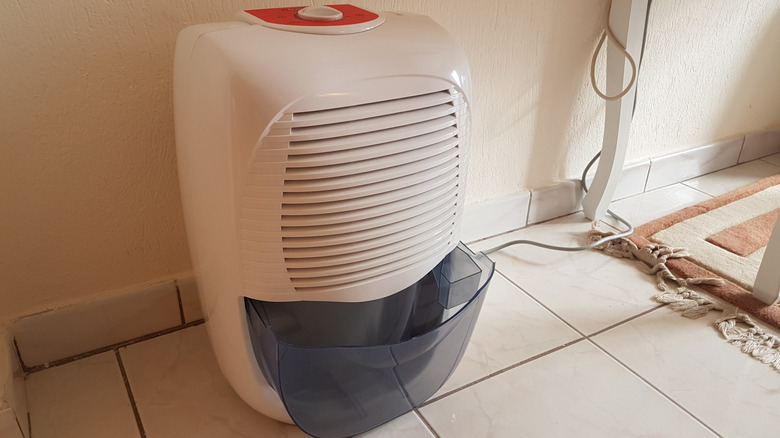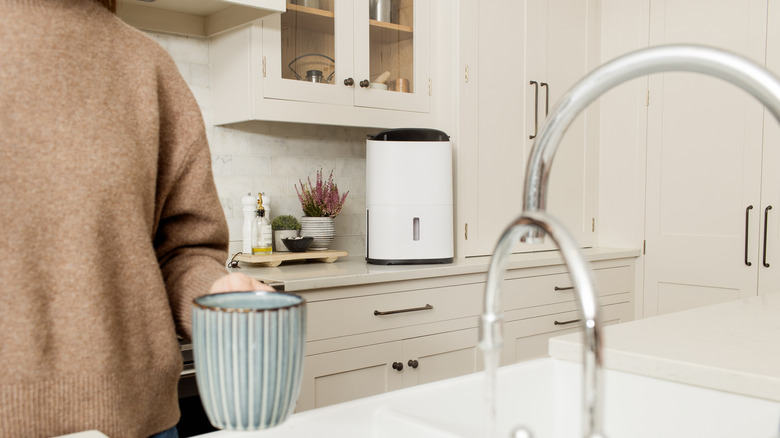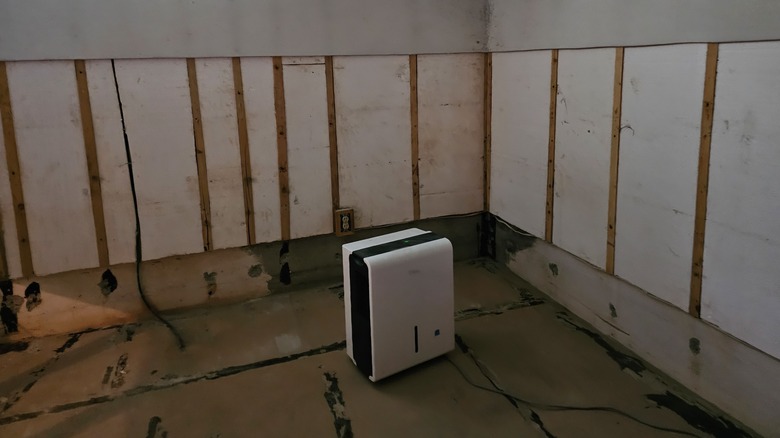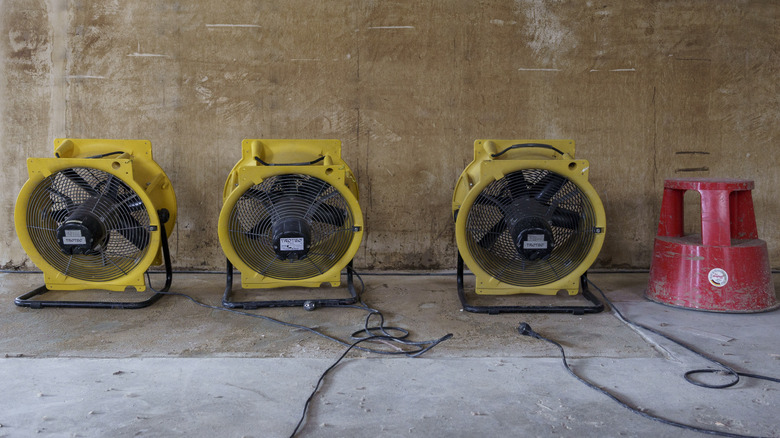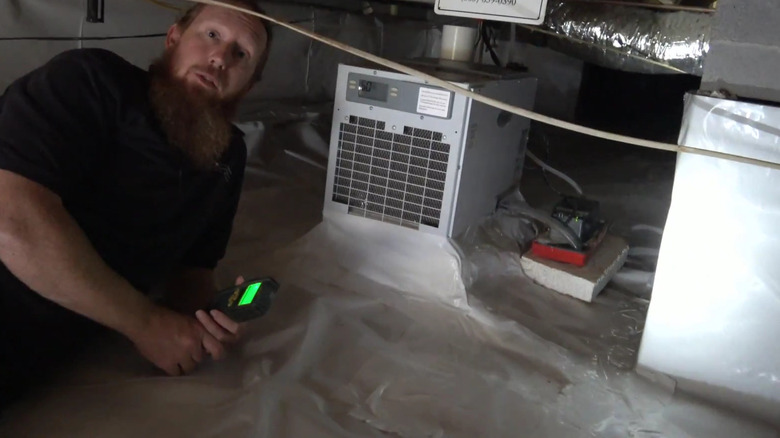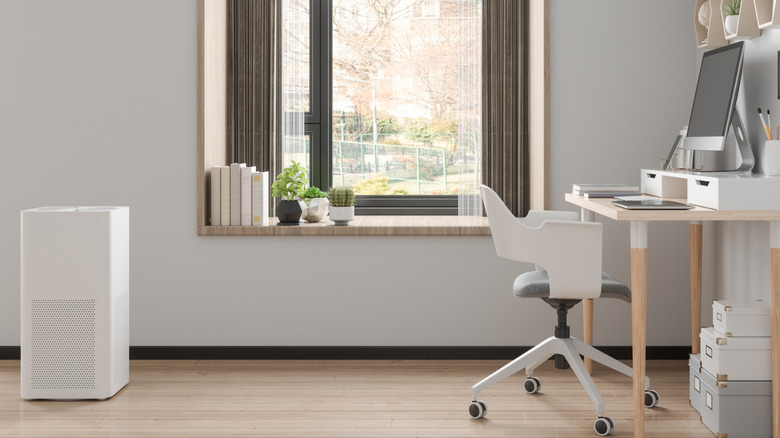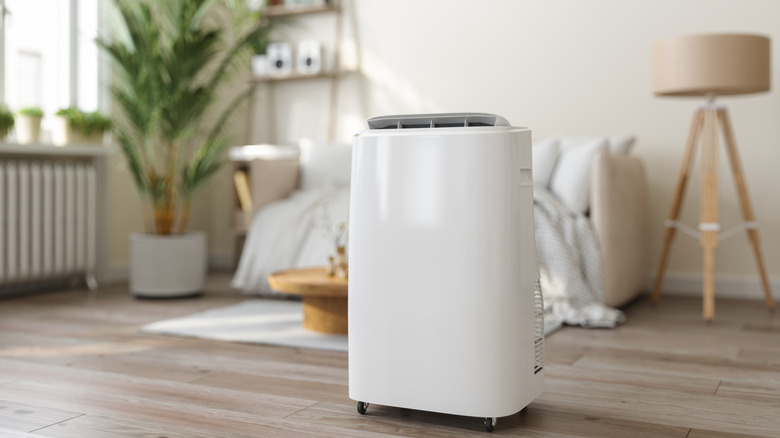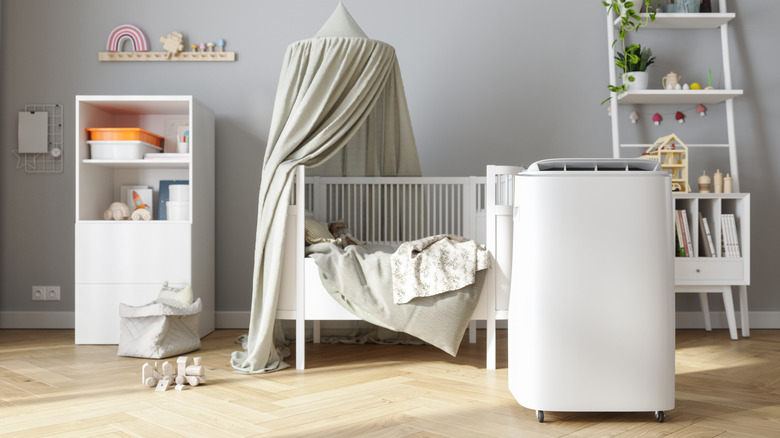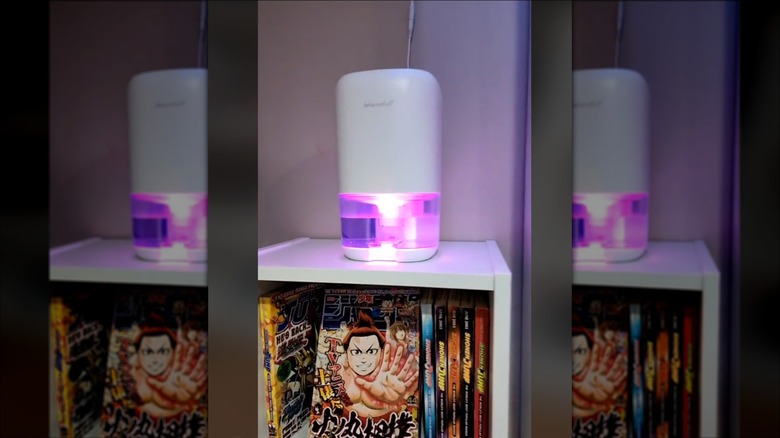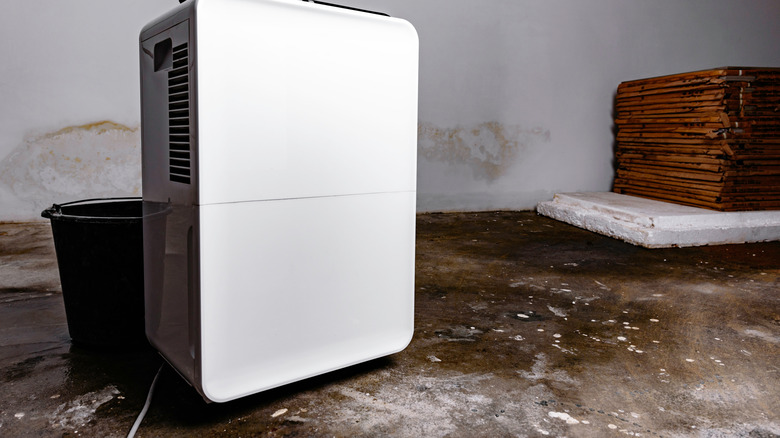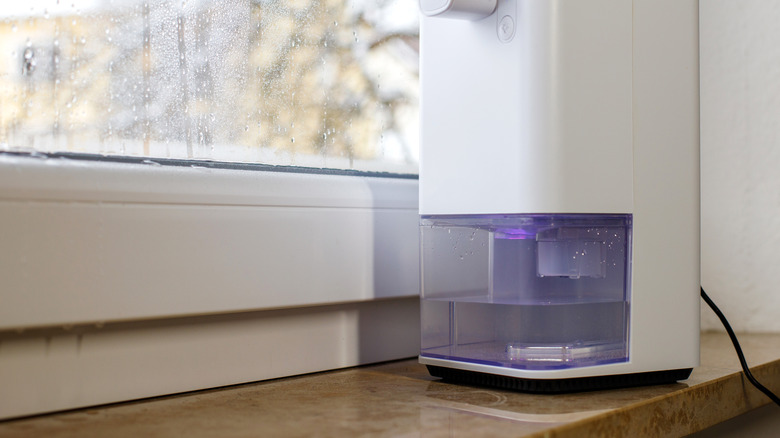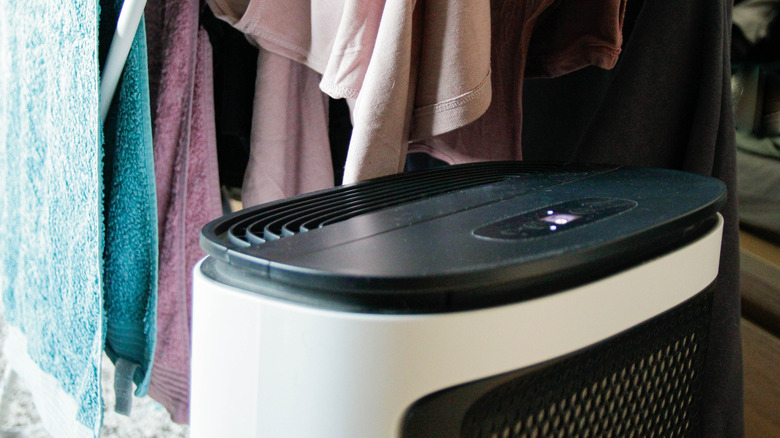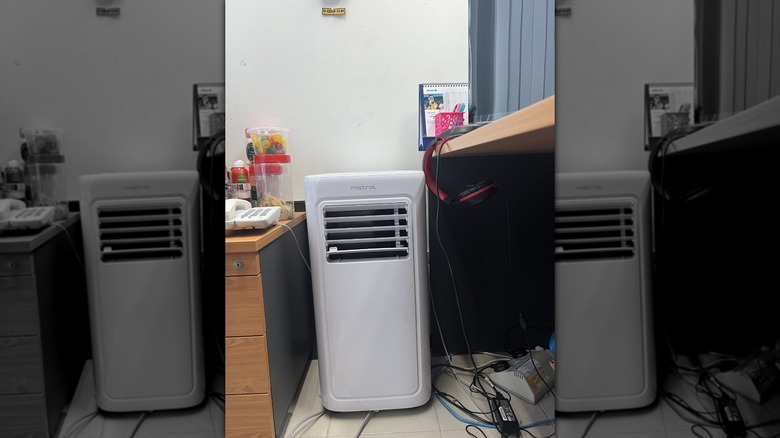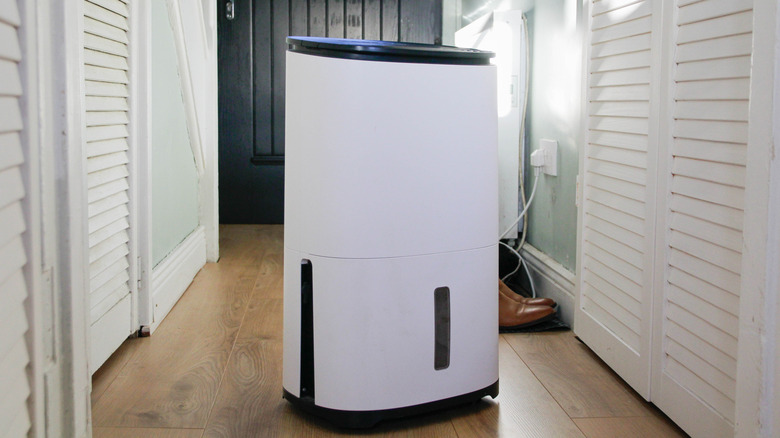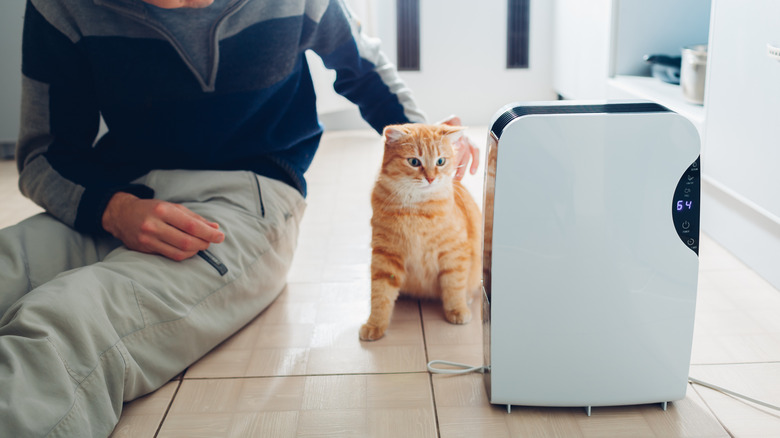17 Unlikely Places You Can Use A Dehumidifier To Maximize The Benefits
When you hear the word "dehumidifier," you probably start to imagine an area with water damage, or running one of these powerful little machines for relief when sick. But have you ever considered how high levels of humidity can affect areas like closets or home offices? Humidity has a sneaky way of ruining books and even shortening the lifespan of electronics. If humidity levels are too high for an extended period of time, it can turn your space into a breeding ground for mold and unpleasant, musty odors. The good news? A dehumidifier can do more than just keep your basement dry. With the right placement in unlikely areas like kitchens, crawl spaces, and near electronics, you can maximize the benefits of a dehumidifier and help keep these spaces at their ideal humidity.
There are different types of dehumidifiers, each with its own uses and benefits depending on the scenario. The main types most people are familiar with include standalone floor units, whole-home dehumidifier units, and tabletop varieties that use desiccant beads. However, the right choice will depend on factors like room size and humidity levels. While standalone units work well for large, moisture-prone areas, tabletop models are perfect for smaller spaces.
Bathrooms
Bathrooms can handle high levels of humidity, but that doesn't mean they are immune to humidity problems overall. Things like steamy showers and poor ventilation can lead to issues such as mold or peeling paint due to condensation buildup (even with an exhaust fan). Placing a small dehumidifier in a bathroom can help to minimize the amount of condensation that builds up in the room by absorbing the excess moisture. Be sure to place the dehumidifier away from anywhere it could come into direct contact with water.
Campers or RVs
If you store a camper or RV in your garage for extended periods during the off-season, a dehumidifier is a must for keeping the interior free from moisture buildup. When you have an entire vehicle sitting unused month after month, humidity can get trapped inside and cause severe issues like mold and mildew to grow on surfaces. You can use a dehumidifier machine or a desiccant model if you don't have the ability to check in frequently. It's also helpful to air out the camper as often as possible during dry weather to keep good airflow.
Storage rooms
Due to their unique designs, storage rooms have minimal ventilation. This stuffy environment makes them susceptible to high humidity levels that can damage what you're trying to keep in the space. For example, paper goods, clothing, furniture, and electronics can all deteriorate in an overly damp environment. A small dehumidifier is one of the best ways to fight back against those musty odors and protect your items. Opt for a model with a timer function to regulate moisture that doesn't use excessive amounts of unnecessary energy.
Kitchen pantry
An ideal pantry should be a dry, cool space to keep goods fresh for as long as possible. However, excess humidity can lead to issues like food spoilage and, in severe instances, pest infestations. Flour and grains are particularly sensitive to moisture, which can lead to the growth of pantry pests called weevils. This is why you should consider putting a dehumidifier in your kitchen pantry, especially for pantries near dishwashers where moisture tends to accumulate. Keeping humidity levels low can help preserve food quality and prevent common storage problems overall.
Basement
Basements are naturally damp and humid due to their cooler temperature. This means that any excess moisture in the home can lead to serious issues and, in worst-case scenarios, foundation damage. These risks make a dehumidifier necessary to maintain structural integrity as a whole. Even finished basements are at risk, as carpets and drywall have the ability to absorb moisture over time. However, a large dehumidifier with a built-in pump helps keep humidity levels in check. For best results, use hygrometers to monitor moisture levels, and if necessary, install a continuous drainage system.
Attic
Attics are known for being a prime storage area in homes, but they also have incredibly poor airflow compared to other areas. This means it can allow heat and moisture to accumulate, which can lead to warped wood or mold forming on everything from the unfinished walls to items you're storing in the space. Many homeowners rarely check their attics, meaning high levels of humidity can go unnoticed and cause damage for a long period of time. A small dehumidifier with a built-in humidistat helps maintain humidity levels and protects your holiday decorations, old photographs, and vintage items.
Crawl space
Crawl spaces are one of the most moisture-prone areas of a home, and once you add in issues like poor drainage, they are at an increased risk of high humidity levels. Being exposed to a lot of moisture like this makes them ideal environments for rot to set into the wooden structures that support your home. One way to combat this is to use a dehumidifier with a built-in drainage hose to regulate humidity and protect both insulation and foundation materials. Choosing options with automatic shut-off means less time you have to worry about under-the-house maintenance.
Near electronics
While you may think of water damage to electronics as something like spilling a glass of juice on them, as a whole, electronics are items that are highly sensitive to all kinds of moisture. This means that when left in areas with excess humidity, they may experience severe issues like internal condensation and serious corrosion. These effects can happen to computers, televisions, and gaming consoles. Placing a dehumidifier near entertainment centers or in computer rooms can help protect expensive electronic items. This is especially important in coastal or high-humidity climates, where damp air can accelerate damage.
Living room
The living room is often one of the largest areas of the home where people gather to unwind, spend time together, and entertain guests. However, individuals may not always realize that their living rooms are one of the first areas guests will see and might be the area they spend the most time in when visiting. Even if you don't notice any obvious issues with air quality, sneaky pollutants can leave lingering musty odors. Use a dehumidifier in your living room to combat any humidity and lurking smells before guests arrive.
Bedroom
A good night's sleep starts with clean air, but high humidity can make your bedroom feel damp and stale. If you wake up congested or have noticed condensation on your bedroom windows in the mornings, these are telltale signs that a dehumidifier is needed. The size you'll need for a bedroom depends on the square footage and humidity levels overall, but the ideal range for most homes falls around 40%. The great thing about a small dehumidifier is that you can run it as needed to keep the range comfortable for your specific preferences.
Home library
Books are one home item that falls under the category of being incredibly susceptible to moisture damage. A low-noise dehumidifier in a home library is an ideal way to protect delicate book bindings while boosting moisture absorption that can cause pages to deteriorate. You'll want to set the humidity level between 30-50% to make sure books stay in pristine condition without overly drying out. If your library has leather-bound books, you can place smaller desiccant dehumidifiers on shelving. For added protection, don't store books too tightly to one another on shelves for airflow.
Garage
Due to their lack of insulation, garages are prone to temperature fluctuations. Even if this isn't an area where you spend a lot of time, unbalanced humidity can lead to serious problems like rusted tools or mold growing on things you're trying to store during off-seasons. Installing a medium to high-capacity dehumidifier can regulate the levels and keep the air dry to prevent condensation buildup. Be sure to look for models with auto shut-off and auto defrost, especially in colder climates where garages experience freezing temperatures. Placing the dehumidifier near tool benches can also help.
Near windows
Windows may let in natural light, but they can also be a major source of excess moisture in the home. This can be caused by window seals that need replacement, cracked frames, or other types of structural issues. Some of the warning signs your windows are letting in dampness include condensation forming on glass panes or sills. Placing a dehumidifier near any affected windows helps reduce condensation buildup and prevent long-term damage. Pairing it with proper insulation and weather stripping is another way to help windows stay dry and free from humidity-related issues throughout the year.
Walk-in closet
Closets are often overlooked when it comes to humidity, but moisture can cause your clothes to pick up a musty-smelling odor or even something as serious as fabric deterioration. This is especially common in seasonal wardrobes and linen closets, where you may not check in on the items as often. Using a small dehumidifier in your closet helps regulate moisture and keeps the air fresh, reducing the risk of musty odors settling into fabrics. For best results, periodically air out the space and use additional moisture-absorbing products alongside the dehumidifier.
Home office
Comfort is key in a home office, especially for those who work from home, and air quality can impact well-being. If your home office is prone to high humidity levels, it means the space is at an increased risk for air pollutants. This is not only a concern for individuals with respiratory issues, as poor air quality can also have cognitive effects like struggling to focus. Placing a small dehumidifier in the area can help keep humidity levels balanced and reduce the number of pollutants to keep the air feeling fresh
Entryway or mudroom
Entryways and mudrooms are some of the first places our wet shoes, rain jackets, and umbrellas may see, but that doesn't mean all that moisture has to linger after you've stepped inside. An expertly placed dehumidifier in the area can help absorb some of that extra condensation and prevent it from causing water damage to the flooring. If your mudroom includes storage cubbies or shoe racks, try placing the dehumidifier near them for extra protection. Though an unlikely place for a dehumidifier, this placement can keep outdoor equipment in better shape year-round.
Pet sleeping area
Your pet's sleeping area might be cozy, but humidity can make it a breeding ground for stinky bacteria and dust mites. In small amounts, these things may not be a big deal, but over time, they can cause respiratory issues and tough-to-remove odors. A small but quiet dehumidifier helps keep the space dry and fresh and reduces the risk of these problems. For added protection, be sure to wash your pet's bedding regularly, use moisture-resistant mats, and try to keep ventilation throughout the space to keep it as comfortable as yours.
